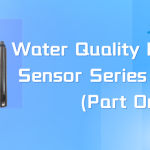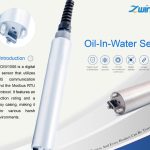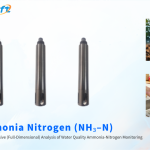Seven Tips for Choosing pH Electrodes
pH is a parameter measured in wastewater and freshwater laboratories worldwide. One of the best ways to measure this parameter is by combining a benchtop or handheld pH meter with a pH probe or electrode. In some applications, specialized probes are necessary to obtain accurate pH data. This article introduces some specific features of pH probes to consider when optimizing pH measurements!
01/Connector Type
First, check the connector to ensure compatibility between the pH probe and the instrument. For example, the ZWIN-CONT1006 is compatible with any IDS (Intelligent Digital Sensor) probe through its proprietary connector, but with an adapter, it can also connect to common BNC analog connectors.
The IDS connectors are easy to install and come standard with ZWIN-CONT1006 instruments. They are color-coded according to parameters for easy use. The pH is yellow-coded, allowing for a clear understanding of the parameter being measured at a glance from both the connector and the screen. IDS sensors enable the inclusion of temperature in a single cable, which means that the same probe can be used to measure both temperature and pH values.
With the use of an adapter, ZWIN-CONT1006 can also be used with any BNC analog connector. Probes with BNC connections are analog signal probes, which means there is a direct millivolt (mV) signal between the pH probe and the instrument. BNC probes can be used with any meter that has a BNC connector. Since the signal is an analog signal, many BNC-based pH probes do not include a thermistor; in this case, a separate temperature probe can be used for accurate pH measurements. If another temperature probe is used on the ZWIN-CONT1006, a setting can be employed to «borrow» the temperature from that probe, effectively replacing the need for a dedicated temperature probe.
Additionally, IDS sensors can be equipped with a plug-in head and a connectable universal radio module, adding wireless capabilities to a single probe. This means that there is no longer a need to bring samples to a desktop meter. Instead, measurements can be taken on-site with the sensor as long as the measuring instrument is within the radio range.
02/Filling Solution
We also need to consider the filling solution. This internal reference solution is a part of the pH probe and is used to maintain a stable potential inside the probe.
Many probes come equipped with a gel reference solution, which is simple and reliable for most laboratory work. The gel reference solution cannot be refilled, but it remains stable for a long time and requires almost no maintenance. There is also no need to worry about changing the filling solution.
If you wish to have more control over the reference solution, you can opt for a refillable probe. You can supplement a refillable probe with additional reference solution as needed. Only when the level of the filling solution is higher than the level of the substance being measured can a refillable pH probe function properly, so please ensure that the probe is filled to the recommended filling solution level.
03/Glass Membrane Shape
In some cases, the shape of a pH electrode is important. Some common shapes include spheres, cones, and cylinders, which are similar in that they all have a rounded glass membrane at the end. The rounded surface has a larger surface area and provides a higher measurement sensitivity. Other membrane shapes are shown in the table below:

04/Junction Type
Next, Let’s briefly discuss the types of junctions for pH probes. The junction is where the filling solution flows out, maintaining a constant potential inside the probe. Regardless of the type of junction used in a pH probe, ensure that it is fully immersed in the sample to ensure consistent results.

Platinum wire junction is a common type of junction. It is a bundle of fine platinum wires that allow a small amount of outflow and serve as a good general-purpose junction.
Another type of junction is the ground joint, which surrounds the entire circumference of the probe. This type of junction allows a large outflow and is designed for rapid discharge of filling solutions in applications with particularly thick or particulate matter. It also performs well in applications with low ionic strength.
Fiber junction, also known as Pellon junction, is similar to the wick in an oil lamp. This design is akin to other environmental products designed for fieldwork.
Some pH probes use a double junction reference system. This system is robust and resistant to backflow effects, with a fast response time. The secondary junction means that the probe can continue to function even if a backflow event occurs.
05/Temperature
Temperature is a key factor in pH measurement. The Nernst equation shows that temperature is one of the variables required to determine the activity of hydrogen ions in a solution. Without accurate temperature readings, accurate pH values cannot be obtained!

Many modern probes integrate temperature measurement. For the probe does not have integrated temperature functionality,please ensure a separate temperature probe is available. If the sample temperature is constant, manual input of temperature on the instrument can also be an option. However, as pH value is highly dependent on the system temperature, it is usually best choice to measure the current temperature using the probe.
06/Replacement Cycle
Do you have an older pH probe whose speed or accuracy has deteriorated? Since the functional end of the equipment is a consumable, pH probes need to be replaced regularly. After extended use, the surface of the probe may develop small cracks, causing the system to «short-circuit» and resulting in inaccurate readings. The filling solution in any electrode, whether gel-filled or liquid-filled, has a limited lifespan. Once the pH probe fails, it must be replaced to restore accurate pH readings. Most laboratory pH probes have a lifespan of about one year., depending on storage conditions, maintenance, and the strictness of the applications.
 Tianjin Zwinsoft Technology Co., Ltd
Tianjin Zwinsoft Technology Co., Ltd





您好!Por favor Iniciar sesión